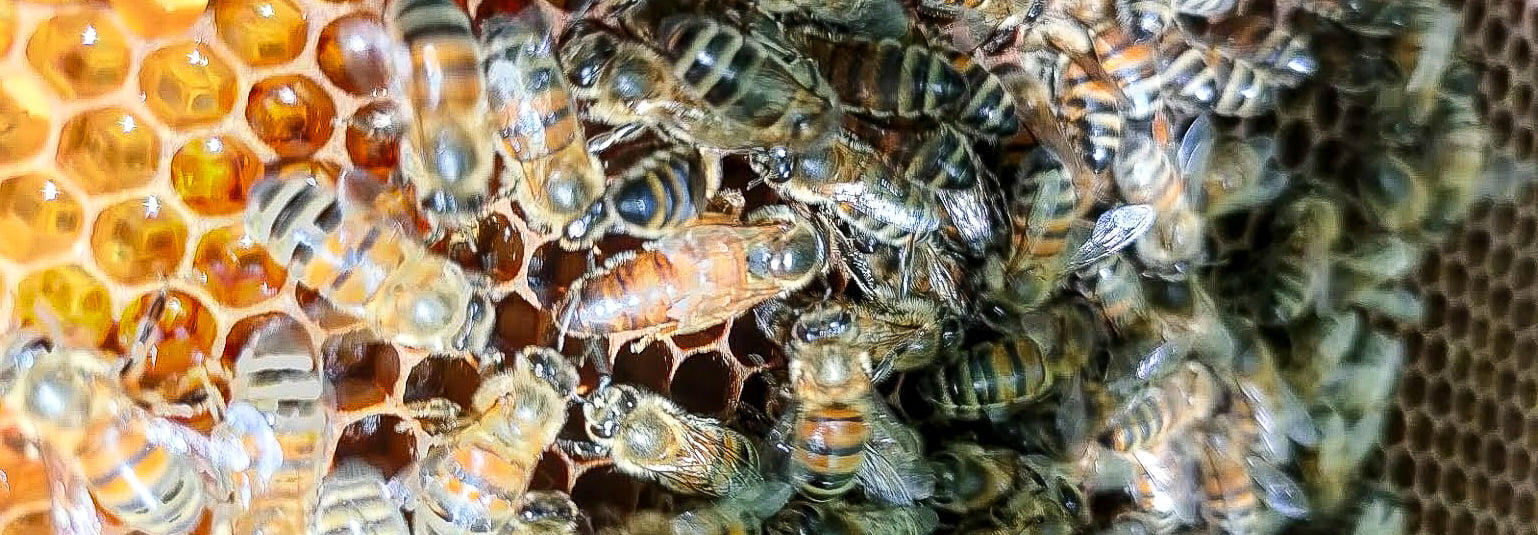
Montcaud’s Queens
Château de Montcaud is home to at least 17 queens with a court of tens of thousands – depending on the weather conditions. You guessed it, we are talking about our bee colonies! But do you also know how we came about keeping bees?
To be frank, it was pure coincidence – or let’s say fate: while restoring our overgrown park to its full glory, we discovered a weathered wall-like structure along a part of the original wall. Thanks to our neighbours, we found out this had been used for beekeeping during the chateau’s days as a family home. Without hesitation, we decided that the bees must return to Montcaud! Beekeeping is currently experiencing a worldwide revival; biodiversity and the protection of these animals are important issues. To top it off, our very own honey can now be served in our two restaurants.
With a bit of TLC, the Montcaud bee population has grown to 17 colonies. They produce a few kilograms of honey each year, but the quantities harvested vary greatly, anything between 50 and 300 kilos per year is possible. After all, our honey is 100% natural and is therefore subject to fluctuations due to climate influence: if it is rather cool and rainy, the colonies are smaller and less active, and the harvest is correspondingly smaller.
A true luxury product for our guests
“As the climate is very mild all year round, there is rarely a need to feed our bees” says amateur beekeeper Rolf Bertschi, “even in winter we consider this only in absolutely exceptional cases, i.e., when a colony is weakened.” Montcaud honey is therefore purely made from collected nectar and not from sugar water, as is often the case with industrial honey. This 100% naturalness makes it a true luxury product.
Climate variations do not only affect the quantity, but can also have an impact on the colour or the viscosity – but little on the taste, as this depends on the plants in the environment, and these stay the same. To make the honey liquid and thus more usable, we reheat it after centrifuging and let it cool very slowly. And then it is ready for our breakfast buffet or desserts: can it get any more local? Evidently, this also means that most of our harvest is quickly used up.
Learning by Talking
After many successes (and a few failures), the original coincidence has grown into a cherished hobby. The know-how comes mainly from exchanges with beekeepers in the area and their tips and tricks – “learning by talking”, so to speak. This is also how we learned to optimize the feeding chain: Instead of taking all the honey away from the bees, attachments are made to the bee boxes, which the bees only fill once the original hive is full. What has been offered in the box attachments is then harvested for our human use, what’s in the hives is for the bees.
Breakfast table meeting?
In spring and early summer, when everything is in bloom, our hardest workers are particularly active. Discretely – close encounters are not to be expected. However, the bees’ distinctive buzzing can be heard clearly near the somewhat hidden boxes, and with a little luck you can observe the peaceful insects drinking at the garden pond. Especially when it is very dry and hot.
“Many guests do not consciously meet the bees and may only be made aware of their important presence when they taste our honey at the breakfast table,” says Rolf Bertschi and adds, “that leads to many interesting conversations and we’ve also already been able to get some guests excited about the subject.” Will there be more hives now? “No, that’s enough for now – we have enough honey for our kitchens and our guests, we don’t need any more,” says Rolf Bertschi.
Harvest starts around mid-June and goes on well into autumn, depending on the weather. Other than that, bees need little attention: the colonies organise themselves perfectly. Regular checks remain essential, and quick action if a colony has problems. Or we may add new hives to keep more bees(y)… who knows?
